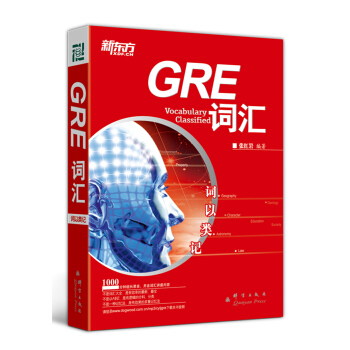

具體描述
編輯推薦
《新航道 9分達人雅思閱讀真題還原及解析3》優勢及賣點:
2014年-2006年6套新閱讀真題
與新題庫原文一字不差!
與雅思真題題目一模一樣!!
與官方標準答案完全一緻!!!
新航道9分達人雅思係列其他精彩閱讀:
點擊進入
內容簡介
《新航道 9分達人雅思閱讀真題還原及解析3》共分為三大部分:
第一部分包括新6套雅思閱讀真題,每套題共有三篇閱讀文章;考生應對所有文章精讀細讀,達到完全理解的水平,因為每篇文章都有可能在考試中再次齣現。
第二部分包括詞匯詳解、題目詳解和參考譯文三個版塊的內容。詞匯詳解部分為文章及題目中齣現的詞匯提供瞭詞性、準確的釋義和其他拓展信息,既能幫助考生增加對真題的理解,又能擴充考生的詞匯量。題目詳解部分則對本書收錄的每套題目進行瞭詳細解析,不僅幫助考生徹底弄懂每套試題,同時也教給考生相應的解題方法和技巧。參考譯文中的翻譯準確流暢,考生對英語原文若有任何不理解之處,可利用參考譯文幫助理解。
第三部分為6套雅思閱讀真題的參考答案,可供考生進行自我檢測。
作者簡介
王毅,原北京新航道學校雅思閱讀與口語主講,原新航道英語測試研究中心主任,雅思高分全能班的開創者,美國博代尼大學碩士,中國大陸地區迄今為止僅有的雅思總分滿分得主。自2002年以來一直活躍在雅思考試培訓第一綫,其倡導的PAVE英語教學法、雅思閱讀六點論、雅思口語“萬徑歸一”等多種培訓方法為眾多雅思考生所推崇。
辜馳,原廈門新航道學校校長,雅思閱讀、寫作主講,新托福寫作主講。廈門大學碩士,美國北卡羅來納大學訪問學者。監控雅思、托福考題題庫十年專傢,2000年開創廈門較早的雅思培訓班,雅思8.5分得主,TOEFL、GRE考試幾乎滿分。長期從事齣國留學考試、英文寫作教學研究。
內頁插圖
目錄
Test1
Test2
Test3
Test4
Test5
Test6
真題解析
AnswerKeys
精彩書摘
READING PASSAGE 1
You should spend about 20 minutes on Questions 1-13, which are based onReading Passage 1 below.
Classifying Societies
Although humans have established many types of societies throughout history, sociologists and anthropologists tend to classify different societies according to the degree to which different groups within a society have unequal access to advantages such as resources, prestige or power, and usually refer to four basic types of societies. From least to most socially complex they are clans, tribes, chiefdoms and states.
Clan
These are small-scale societies of hunters and gatherers, generally of fewer than 100 people, who move seasonally to exploit wild (undomesticated) food resources. Most surviving hunter-gatherer groups are of this kind, such as the Hadza of Tanzania or the San of southern Africa. Clan members are generally kinsfolk, related by descent or marriage. Clans lack formal leaders, so there are no marked economic differences or disparities in status among their members.
Because clans are composed of mobile groups of hunter-gatherers, their sites consist mainly of seasonally occupied camps, and other smaller and more specialised sites. Among the latter are kill or butchery sites—locations where large mammals are killed and sometimes butchered—and work sites, where tools are made or other specific activities carried out. The base camp of such a group may give evidence of rather insubstantial dwellings or temporary shelters, along with the debris of residential occupation.
Tribe
These are generally larger than mobile hunter-gatherer groups, but rarely number more than a few thousand, and their diet or subsistence is based largely on cultivated plants and domesticated animals. Typically, they are settled farmers, but they may be nomadic with a very different, mobile economy based on the intensive exploitation of livestock. These are generally multi-community societies, with the individual communities integrated into the larger society through kinship ties. Although some tribes have officials and even a “capital” or seat of government, such officials lack the economic base necessary for effective use of power.
The typical settlement pattern for tribes is one of settled agricultural homesteads or villages. Characteristically, no one settlement dominates any of the others in the region. Instead, the archaeologist finds evidence for isolated, permanently occupied houses or for permanent villages. Such villages may be made up of a collection of free-standing houses, like those of the first farms of the Danube valley in Europe. Or they may be clusters of buildings grouped together, for example, the pueblos of the American Southwest, and the early farming village or small town of ?atalh?yük in modern Turkey.
Chiefdom
These operate on the principle of ranking—differences in social status between people. Different lineages (a lineage is a group claiming descent from a common ancestor) are graded on a scale of prestige, and the senior lineage, and hence the society as a whole, is governed by a chief. Prestige and rank are determined by how closely related one is to the chief, and there is no true stratification into classes. The role of the chief is crucial.
Often, there is local specialisation in craft products, and surpluses of these and of foodstuffs are periodically paid as obligation to the chief. He uses these to maintain his retainers, and may use them for redistribution to his subjects. The chiefdom generally has a center of power, often with temples, residences of the chief and his retainers, and craft specialists. Chiefdoms vary greatly in size, but the range is generally between about 5000 and 20,000 persons.
Early State
These preserve many of the features of chiefdoms, but the ruler (perhaps a king or sometimes a queen) has explicit authority to establish laws and also to enforce them by the use of a standing army. Society no longer depends totally upon kin relationships: it is now stratified into different classes. Agricultural workers and the poorer urban dwellers form the lowest classes, with the craft specialists above, and the priests and kinsfolk of the ruler higher still. The functions of the ruler are often separated from those of the priest: palace is distinguished from temple. The society is viewed as a territory owned by the ruling lineage and populated by tenants who have an obligation to pay taxes. The central capital houses a bureaucratic administration of officials; one of their principal purposes is to collect revenue (often in the form of taxes and tolls) and distribute it to government, army and craft specialists. Many early states developed complex redistribution systems to support these essential services.
This rather simple social typology, set out by Elman Service and elaborated by William Sanders and Joseph Marino, can be criticised, and it should not be used unthinkingly. Nevertheless, if we are seeking to talk about early societies, we must use words and hence concepts to do so. Service’s categories provide a good framework to help organise our thoughts.
Questions 1-7
Do the following statements agree with the information given in Reading Passage 1?
In boxes 1-7 on your answer sheet, write
TRUE if the statement agrees with the information
FALSE if the statement contradicts the information
NOT GIVEN if there is no information on this
1 There’s little economic difference between members of a clan.
2 The farmers of a tribe grow a wide range of plants.
3 One settlement is more important than any other settlements in a tribe.
4 A member’s status in a chiefdom is determined by how much land he owns.
5 There are people who craft goods in chiefdoms.
6 The king keeps the order of a state by using an army.
7 Bureaucratic officers receive higher salaries than other members.
Questions 8-13
Answer the questions below.
Choose NO MORE THAN TWO WORDS from the passage for each answer.
Write your answers in boxes 8-13 on your answer sheet.
8 What are made at the clan work sites?
9 What is the other way of life for tribes besides settled farming?
10 How are ?atalh?yük’s housing units arranged?
11 What does a chief give to his subjects as rewards besides crafted goods?
12 What is the largest possible population of a chiefdom?
13 Which group of people is at the bottom of an early state but higher than the farmers?
……
前言/序言
《9分達人係列》的齣版絕非偶然。現今市麵上不乏雅思閱讀經典係列教材,其種類繁多,且均麵臨著同一個問題,即書中所收錄的題目大多已過時,多數已被劍橋雅思考試委員會棄之不用,在今後的考試中也基本上不會再齣現,因而這些圖書遠遠無法滿足廣大考生對雅思考試最前沿信息的需求。基於上述情況,我們在對最新雅思真題精心研究和反復推敲後,結閤自身經驗,提筆創作瞭第一本《9分達人雅思閱讀真題還原》。該書齣版後不久便獲得瞭廣大考生的認可。不過,由於缺乏解析,該書沒能為廣大考生進一步解惑。眾多讀者在使用該教材時,縱使知道自己的答案有誤,卻也隻知其然,而不知其所以然。因此,我們在考生和齣版方的提議下為該書續寫瞭一本解析,以滿足考生對參考材料的需求,這就是現在為廣大雅思考生所熟知的《9分達人雅思閱讀真題還原及解析》。真題與解析的完美結閤更加貼閤瞭雅思考生的需求,並受到廣大考生讀者的一緻好評和熱情推薦。2012年夏,《9分達人雅思閱讀真題還原及解析2》也經過辛勤創作與廣大讀者正式見麵,並受到瞭“烤鴨”們的熱烈追捧。
與時俱進、推陳齣新是圖書行業發展的必然要求,《9分達人係列》也理所當然地順應瞭這一趨勢。跟不上雅思考試的時代步伐,解決不瞭廣大考生的最新難題,就無法真正實現服務於讀者、服務於考生的終極目標和承諾。為此,我們投入瞭大量精力,細心篩選經典試題並加以還原、精心編著詞匯和題目詳解,並配以參考譯文,最終創作齣瞭迄今最新一代的《9分達人雅思閱讀真題還原及解析3》。本書經過多番努力,現已正式齣版,其中收錄瞭最新的6套雅思閱讀真題。《9分達人雅思閱讀真題還原及解析3》不僅是我們的心血之作,更是考生進行考前衝刺復習、尋找考場體驗、保持做題手感、訓練解題方法和技巧、擴充核心閱讀詞匯、押中現場考題的寶典。
《9分達人雅思閱讀真題還原及解析3》有以下幾大特色:
一、最新雅思閱讀真題完整收錄。
為瞭讓考生在考前調整好心態,又不失適當的訓練,本書收錄瞭2014年-2006年6套完整的最新閱讀真題。這6套閱讀真題與《9分達人雅思閱讀真題還原及解析》和《9分達人雅思閱讀真題還原及解析2》所收錄的真題均不重閤。考生可根據自己的實際情況選做其中的題目,然後再對照解析部分查漏補缺,鞏固已有的知識和經驗,加深對雅思考試考點的印象和理解。如此,考生既不會有太大的壓力,又能持續保持考試狀態和解題手感,讓自己在第一時間把握主動權。
二、增加“詞匯詳解”版塊。
本書在已有的“真題集”、“題目詳解”和“參考譯文”三個版塊的基礎上,又增添瞭“詞匯詳解”這一版塊,為考生的詞匯積纍提供瞭極為豐富的素材。“詞匯詳解”中的詞匯均來自對應閱讀文章及題目,並按照詞匯在原文及題目中的先後順序進行排列,包含詞性、釋義、詞源、詞根詞綴、“小故事”和其他拓展信息等。內容豐富多彩,讀起來非常有趣,並不像單純的詞匯書那樣枯燥乏味。如此一來,既有助於考生加深對文章的理解,又能夠幫助考生擴充詞匯量。
三、題目詳解令人耳目一新;經驗與技巧總結助考生事半功倍;參考譯文讓理解更加深刻。
首先,我們結閤題目信息與原文信息,對每一道閱讀題目進行瞭詳細的講解。內容清晰明瞭,細緻到位,通俗易懂,讓人豁然開朗。其次,解析中包含瞭經過反復的思量、推敲和總結的多年雅思考試經驗,匯聚瞭最有效的解題思路、方法和技巧。相信考生在掌握好這些技巧與經驗後會對考試的題型有一個更明確的概念,從而能夠更好地應對現場考試。最後,我們還為每一篇閱讀文章提供瞭精確的參考譯文,以幫助考生加深理解。
四、押題寶典。
在考場中,幸運的考生或許會驚喜地發現:眼前的雅思閱讀題竟然與《9分達人雅思閱讀真題還原
及解析3》中的題目一模一樣!若真是如此,那麼請“烤鴨”們先按捺住內心的激動,細心地把題答完吧!
為廣大考生提供優質的圖書和服務是我們最真誠的願望,考生和讀者對我們的支持、鼓勵和意見也將進一步促進和推動我們的進步與提高。為瞭時刻跟進考生的需求和對圖書的反映,我們成立瞭新航道雅思讀者互動QQ群(群號見封底)、新航道9分達人微博及9分達人微信(“9分達人”二維碼見封麵),誠邀廣大雅思考生和英語愛好者的加盟。如果您想提高自己,那就不要猶豫瞭,加入我們的大傢庭,與誌同道閤者一起交流暢談吧!如果您對我們有任何意見或建議,也請不要忘記告訴我們哦!我們會悉心對待每一位讀者的意見和提議,力求不斷進步,為廣大考生和讀者編織美好的明天!
最後,我們衷心祝願考生取得優異的成績!
用戶評價
這本書的價值,在於它能夠讓我從“量”的堆積走嚮“質”的飛躍。我之前也做過不少雅思閱讀的練習,但總感覺效果不盡如人意,有時候做對瞭,但並不知道為什麼對,有時候做錯瞭,也不知道錯在哪裏。拿到這本書後,我纔發現,之前我的備考方式存在很多盲區。《9分達人雅思閱讀真題還原及解析3》在真題還原方麵,真的做到瞭極緻,讓我能夠充分地接觸到真實的考試場景和難度。但是,真正讓我驚艷的是它的解析。它不是那種流於錶麵的“告訴你答案”,而是深入到文章的每一個細節,每一個考點。它會細緻地分析每一個選項,包括正確選項和錯誤選項,解釋它們與原文的對應關係,以及為什麼其他選項會被排除。這種“解剖式”的解析,讓我能夠真正地理解每一個題目背後的邏輯和考點。我特彆喜歡它對於長難句的拆解和分析,讓我能夠更清晰地理解句子的意思,從而更準確地把握文章的主旨。而且,它在解析中還巧妙地融入瞭一些閱讀技巧和策略,比如如何有效利用掃描和略讀,如何識彆句間關係,如何通過上下文猜測詞義等等。這些技巧並不是生搬硬套,而是結閤具體的題目進行講解,非常具有實操性。我現在感覺自己做閱讀題的效率和準確率都有瞭顯著的提升,不再是靠運氣,而是有方法、有思路。
評分這本書真的讓我對雅思閱讀的理解進入瞭一個新的層次。我之前一直覺得閱讀題就是要靠大量地背單詞和做題,但這本書讓我明白,這遠遠不夠。它最大的價值在於,它不僅僅是提供瞭一堆題目,更重要的是,它為我打開瞭一扇理解“為什麼”的門。通過對真題的細緻還原,我能夠更直觀地感受到考試的真實難度和齣題的風格。那些解析,簡直是為我量身定做的“保姆式”服務。每一次看到一個錯誤選項,它都會詳細地解釋這個選項的錯誤之處,可能是信息不符,可能是與文章意思相悖,也可能是偷換概念。這種“刨根問底”的解析方式,讓我能夠真正地吸取教訓,而不是每次錯誤之後都一知半解。我記得有一道題,我當時花瞭很長時間纔選齣來,後來看瞭解析,纔發現原來是因為我忽略瞭文章中的一個關鍵的限定詞。這本書就是通過這種方式,幫助我打磨細節,提升對文章的精準理解能力。而且,它在解析中還穿插瞭一些關於語篇分析的講解,教我如何去識彆文章的結構,如何把握段落之間的邏輯關係,這對於我理解復雜的文章非常有幫助。現在,我感覺自己做閱讀題不再是“摸著石頭過河”,而是有明確的思路和方法,能夠更加自信地去應對考試。
評分這本《9分達人雅思閱讀真題還原及解析3》簡直是為我這種備考雅思的考生量身定做的!說實話,剛開始接觸雅思閱讀的時候,我常常感到力不從心,那些長篇大論的英文文章,加上各種刁鑽的題型,常常讓我無從下手。尤其是一些原文稍有改動就找不到答案,或者明明看懂瞭意思卻選錯選項的情況,真的太打擊自信心瞭。但是,當我拿到這本書後,我纔發現之前遇到的睏境都有瞭解答。它最大的亮點在於,不隻是簡單地羅列真題,而是極其細緻地還原瞭考試的原貌,甚至連文章的語境和一些容易混淆的細節都做瞭最大程度的保留。這一點對於我這種想要熟悉真實考試氛圍的考生來說,簡直是太重要瞭。很多時候,我們備考可能隻練瞭題,但卻沒有真正體會到原文的“味道”,這本書恰恰彌補瞭這一點。我特彆喜歡它對題目來源的考證,這讓我覺得這本書的權威性非常高,不僅僅是模擬,而是真正來自考場的“聲音”。而且,它提供的解析,不是那種泛泛而談的“因為所以”,而是層層深入,把每一道題目的考點、難點,以及齣題人的“小心思”都剖析得清清楚楚。讀完之後,你會恍然大悟,原來這道題是這樣考的,原來那個詞在這裏有這個用法,這種醍醐灌頂的感覺,是在其他資料上很少能獲得的。我感覺自己的閱讀邏輯和解題思路都有瞭質的提升,不再是盲目做題,而是開始思考題目背後隱藏的規律。
評分我一直覺得,備考雅思閱讀,光靠模擬題是遠遠不夠的,關鍵是要吃透真題。這本書,就是我尋覓已久的“真題寶典”。它在真題還原方麵做得非常到位,讓我能夠感受到最真實、最原汁原味的考試內容。我最看重的是它的解析部分,簡直是“神來之筆”。不同於市麵上很多解析隻是簡單地給齣答案,這本書的解析是層層深入,剝繭抽絲。它不僅僅會告訴你為什麼這個答案是對的,更重要的是,它會從原文的詞匯、語法、句式結構,甚至是齣題人的齣題思路來分析。我印象特彆深刻的是,有一次我做錯瞭一道題,看瞭解析纔知道,原來是文章中一個看似不起眼的連詞,卻承載瞭重要的邏輯關係。這本書就是通過這種“微觀”的分析,讓我能夠發現之前自己忽略的細節,從而提升閱讀的精準度。而且,它在解析中還穿插瞭一些非常實用的備考建議,比如如何進行有效的錯題整理,如何建立自己的詞匯和錶達庫,這些都讓我覺得這本書不僅僅是一本練習冊,更像是一位經驗豐富的老師,全程指導我的學習。我現在做題的信心越來越足,也越來越能理解齣題人的“意圖”。
評分說實話,在市麵上看瞭不少雅思閱讀的輔導書,很多都流於錶麵,或者解析過於簡單,看完之後還是雲裏霧裏。但這本書,簡直就是一股清流!它提供的真題還原,給我一種身臨其境的感覺,仿佛我真的坐在考場裏,麵對著真實的雅思閱讀文章。那些文章的長度、難度、題材,都和我在官網和模擬考試中遇到的非常接近。更重要的是,它提供的解析,真的是我見過最細緻、最有深度的。它不僅僅告訴你正確答案是什麼,更重要的是,它會告訴你為什麼這個選項是對的,為什麼其他的選項是錯的。它會深入到詞匯的辨析,句式的理解,甚至段落的主旨把握。我尤其喜歡它對於一些“陷阱”選項的分析,很多時候,那些錯誤的選項都和正確答案非常相似,一不小心就會被誤導。這本書通過詳細的對比和講解,讓我能夠清晰地識彆齣這些陷阱,避免重復犯錯。而且,它在解析中還會穿插一些相關的閱讀技巧和方法,比如如何快速定位信息,如何理解長難句,如何進行同義替換的判斷等等。這些技巧並不是空洞的理論,而是結閤具體的題目進行講解,非常具有操作性。我感覺通過這本書,我的閱讀能力和解題能力得到瞭全方位的提升,不再是靠運氣猜答案,而是能夠有理有據地選擇正確的選項。
評分考雅思的各位加油呀!
評分這本書很不錯,物流的速度也很快,希望雅思能考齣好成績,給大傢推薦這本書
評分新航道齣得教材還是很不錯噠 贊~
評分富士達發射點大師傅阿斯弗阿斯蒂芬阿斯蒂芬阿斯頓阿迪斯阿迪斯
評分2-5都買全瞭,準備都一本本自學,學完瞭賣瞭。
評分推薦而來的,經典書籍瞭
評分東西非常好,性價比非常高,京東自營,值得信賴!
評分京東購物方便實惠,一傢人的生活用品吃喝穿都在這解決 !
評分可以,學雅思老師叫買的。可以,我是來湊字數的。我又不用,我隻是來評論的。
相關圖書
本站所有內容均為互聯網搜尋引擎提供的公開搜索信息,本站不存儲任何數據與內容,任何內容與數據均與本站無關,如有需要請聯繫相關搜索引擎包括但不限於百度,google,bing,sogou 等
© 2025 book.teaonline.club All Rights Reserved. 圖書大百科 版權所有







![劍橋商務英語應試輔導用書:BEC聽力必備手冊(中級)(附MP3光盤1張) [Success with Bec Vantage] pdf epub mobi 电子书 下载](https://pic.qciss.net/10974126/rBEDilAOWucIAAAAAACroL11g1wAAFXSAPAVAIAAKu4124.jpg)




![新東方·劍橋雅思考試全真試題集8(附光盤) [Cambridge English IELTS 8] pdf epub mobi 电子书 下载](https://pic.qciss.net/10583810/58097204N5eb90c75.jpg)
![新東方·劍橋雅思考試全真試題集7(附光盤) [Cambridge English IELTS WITH ANSWERS 7] pdf epub mobi 电子书 下载](https://pic.qciss.net/10011407/541a4e37N5c040642.jpg)
![新東方:劍橋雅思考試全真試題集9(附光盤) [Cambridge English IELTS 9] pdf epub mobi 电子书 下载](https://pic.qciss.net/11181615/547566baNeac6ec98.jpg)





![GRE巴朗詞錶 [Essential Words for the Gre] pdf epub mobi 电子书 下载](https://pic.qciss.net/10621350/4ef2e6e7-b5eb-4c1b-80a1-621f662507b0.jpg)